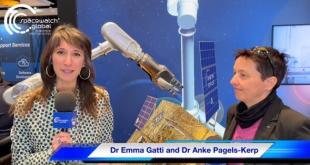By Dr. Emma Gatti
Have you ever wondered what it would be like to live on Mars? AMADEE-20, a Mars-analogue mission born from the collaboration between the Austrian Space Forum, the Israeli Space Agency and another 25 countries tried to answer this question. From anxiety issues to crew rebellion, this is what they are trying to understand.

The idea of living on Mars is a tantalizing concept that people in the Space sector have been playing with for a while. The technological barriers are enormous, the medical issues are a concern and the psychological aspects are fundamentally unknown. How we, social animals that like to stretch their legs in the sun, would react to one year (this is the minimum it would take, with the current technology, to do a “fast trip” to Mars) of isolation in a dark and small living space, 225 million km (on average) from what we call home? AMADEE-20, a Mars analogue mission based in the Negev desert, in Israel, tried to pin down the human reactions to isolation sending six trained analogue astronauts to live for three weeks in a 60 square meter station built specifically to simulate the harsh Mars environment. The goal, among other things, was to simulate the psychological strain that the crew could be exposed to once on Mars, and the human reactions to confinement, limited resources and enormous working pressure.
THE HUMAN FACTOR

The mission was equipped with several psychological experiments to measure the adaptability, mood and mental wellbeing of the astronauts. Among others, there was a study of anxiety and depression by the International Space University (France), a study on social and spatial density in the Mars base habitat by the Weizmann Institute of Science (Israel) to understand how the crew preferred to occupy its habitat, and a study of the responsivity of the team during a long period of isolation and in a highly demanding work context, by the University of Bremen (Germany). Many factors can influence the mental stability of the crew, from lack of fresh food to lack of light, to the working burden, however, the major factor keeping the mood high apparently is the inner connection within the crew. “The biggest factor” Alex de Carvalho, team lead and a psychologist of the Human Factors Team, explains “is cohesion. If the group doesn’t get along, if they don’t like each other, they get stressed. There are studies about scientific crews isolated in the polar regions that show similar results.”
The Mars crew needs also a harmonious connection with Mission Control, the umbilical cord of the team with home. Annabelle Mielitz, a psychologist of the Human Factors Team and master student from Bielefeld University (Germany) explained that “if the Mars crew feel disconnected they might start to take their own decisions, which sometimes is good and sometimes is dangerous because they don’t know all the circumstances that the Earth crew is aware of. It’s important they communicate well and they feel quite close to each other.”
“Mars is much further than the Moon, so you cannot communicate and resolve problems as fast as you would do on our satellite”. Olivia Haider, Board Member of the Austrian Space Forum and member of the Mission Support team for Amadee-20
A 60 SQUARE METER HOME
One of the peculiarities of living on Mars will be the living space, which won’t be anything like Earth. “We designed this mission for three years,” said Alon Shikar, co-founder of D-Mars and architect of the D-Mars station hosting the AMADEE-20 mission. “We wanted to have a very clear idea of the amount of food and water that each astronaut needed, and design everything -from storage place to kitchen appliances to things to grow- based on this budget. Everything had to be calculated to occupy the minimum space possible”.
 The current prototype is the second of its generation. The first one was only 40 square meters; this one is 60 square meters and it includes a clean lab, a control area, and a large area for the astronauts to wear their suits. “It’s quite interesting” added Alon, “because they do not naturally live together, so we try to help them to feel more “at home” building passages to connect the different functions of the habitat”.
The current prototype is the second of its generation. The first one was only 40 square meters; this one is 60 square meters and it includes a clean lab, a control area, and a large area for the astronauts to wear their suits. “It’s quite interesting” added Alon, “because they do not naturally live together, so we try to help them to feel more “at home” building passages to connect the different functions of the habitat”.

“If a house is a machine, a habitat like this is a machine on steroids”. Alon Shikar, co-founder of D-Mars and architect of the D-Mars station hosting the AMADEE-20 mission
The station has to work contemporaneously as a laboratory, a storage room and a house. Water is recycled multiple times through a system of waste management and used to water plants, electricity is provided by large solar-powered systems, and food is restricted to powders (256 pages of a nutrition plan though made sure that the astronauts’ diet is balanced, nutritious and “cheerful” through the entire mission). The house has windows (albeit possibly difficult to have windows on Mars, due to radiation) and a pressure of 1 Earth atmosphere, although airlocks were installed to simulate pressure changes from the outside, similar to a submarine.
A PERFECTLY ENGINEERED FAMILY
 How is it to live on Mars then? “The astronauts wake up at 5:30 am” explains Mielitz. “They have breakfast, then they start going out in the desert with the suit. Then they have lunch, and in the afternoon, they run experiments. In the evening they continue to work and take care of the house. They then cook together, have dinner and have some leisure time before preparing for the next day and go to bed”. Entertainment on Mars is contemplated and encouraged, to avoid the burnt-out effect. Astronauts are encouraged to bring cards, board games and movies. Alcohol is allowed but controlled, to avoid accidents.
How is it to live on Mars then? “The astronauts wake up at 5:30 am” explains Mielitz. “They have breakfast, then they start going out in the desert with the suit. Then they have lunch, and in the afternoon, they run experiments. In the evening they continue to work and take care of the house. They then cook together, have dinner and have some leisure time before preparing for the next day and go to bed”. Entertainment on Mars is contemplated and encouraged, to avoid the burnt-out effect. Astronauts are encouraged to bring cards, board games and movies. Alcohol is allowed but controlled, to avoid accidents.
How about their mood? “We usually observe a wave-type of behavior” explains de Carvalho. “In the beginning, people are highly motivated because everything is new. Then there is a phase of adaptation, during which everything works fine because people know what they are doing. After that, there is a low point, because they start to be tired and realize that resources are scarce and things could go wrong. This is the phase when everything turns moody. It’s not a catastrophe, we just need to be ready for this phase”.
Putting together the right crew took two years of selection and training. “We have been putting a lot of effort in choosing the right people” explained Dr. Gernot Grömer, Director at Austrian Space Forum (OeWF) and Mission Director. “We check hundreds of parameters to select out any pathological traits and select in all the deliverable ones”.
LONGING FOR ADVENTURE
It might seem strange to see small countries like Austria or Israel working on such a big goal project like a Mars human mission. “Amadee- 20 is our thirteenth analogue mission” specifies Olivia Haider, Board Member of OeWF (Austrian Space Forum) and member of the Mission Support team. “Analogue research is a perfect opportunity for smaller countries to participate in the space race. We can try on Earth to simulate what might happen on Mars, and in this way support the space exploration community”. It is also a matter of investment, risk-taking and bold vision, Dr. Grömer adds: “People says that Austria is a small country so we cannot afford such things, but I don’t think it’s a matter of money, I think it’s a matter of vision and to involve the right stakeholders. As long as we are able to make people aware that space is for everyone and is producing a tangible benefit for everyday life we are on a good path. But we should make sure that a small fraction of these expenditures are spent on high-risk projects like space exploration with human space flights because these are the sharpening stones of our strategies, and many technologies can benefit from them. In the end, the main challenge of bringing the people to Mars is not building a big rocket ship but making the people longing for the ocean”.
Ultimately, AMEDEE-20 aimed to focus on the human factor within the context of building a station on Mars. From how the house was planned to how the astronauts were fed, the project kept in mind the physical and technological requirements, but also the “mind needs” of the humans involved. In the end, they noticed that what keeps the crew together is our very human need to feel in sync with each other. Maybe this is something to keep in mind for other working environments here on Earth?

Dr. Emma Gatti is a Cambridge graduated and former NASA scientist with ten years of experience in the field of planetary science and geology. She was working as a post-doctoral scholar at Jet Propulsion Laboratory and California Institute of Technology before returning to Milan in 2018 to start working as a space journalist in the field of Space Economy and Space Policy. She is particularly interested in space colonization, planetary mining and everything regulating the two. She likes Italian coffee, Indian food, French wine, Dutch beer, Swiss trains, Danish policy, Russian theatre, Brazilian cocktails, Egyptian tombs, English television, Australian attitude and American literature.





